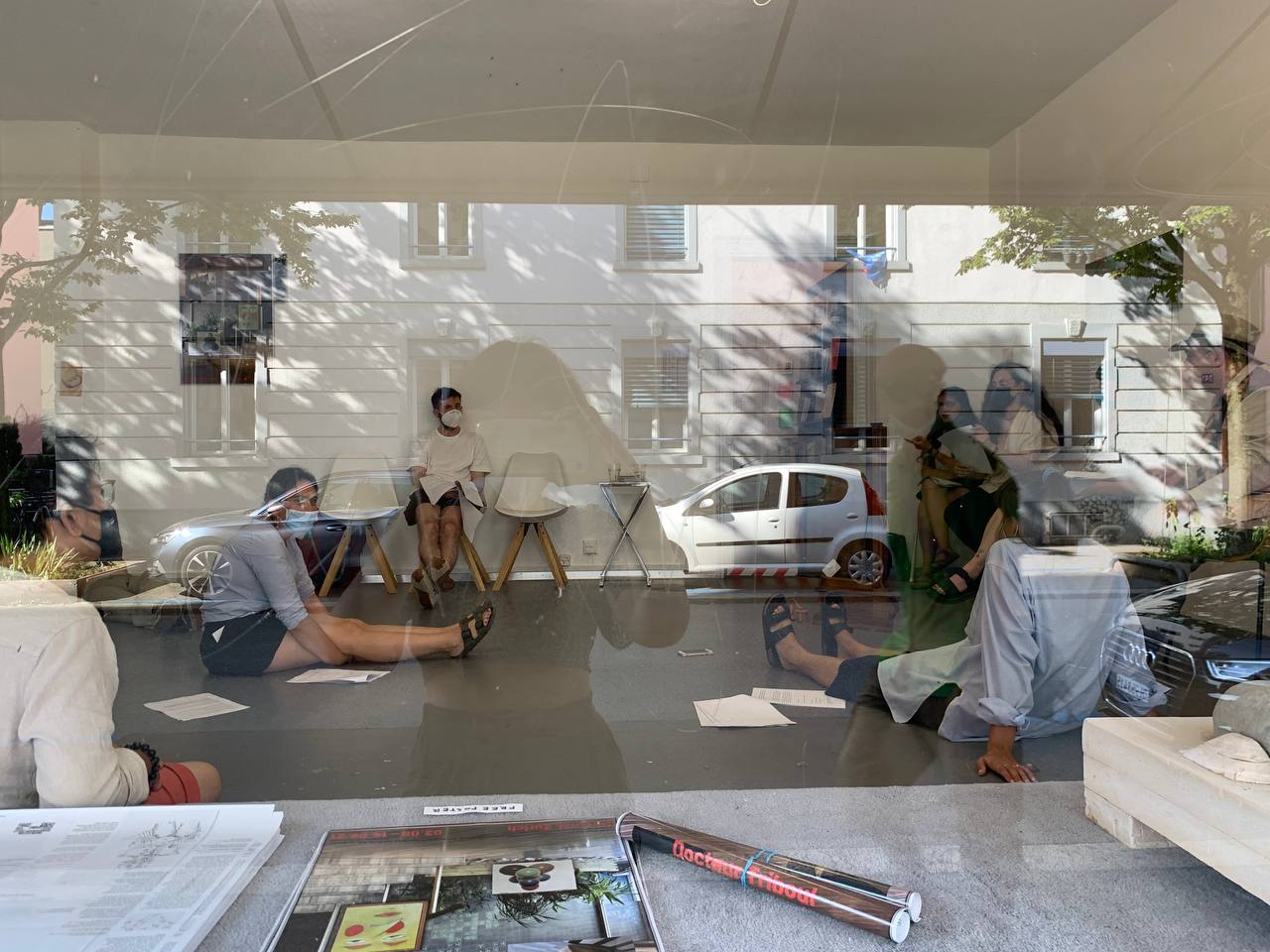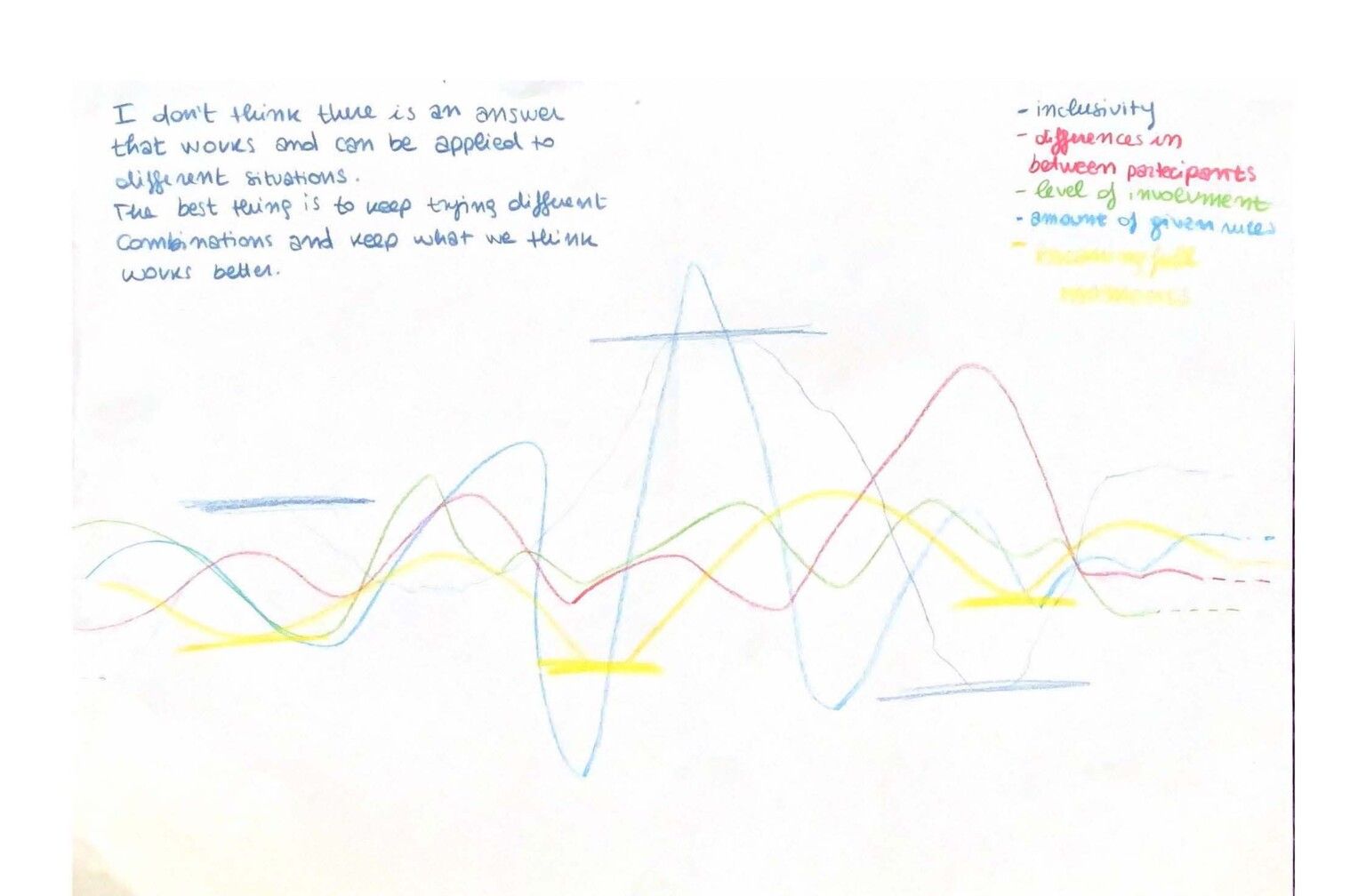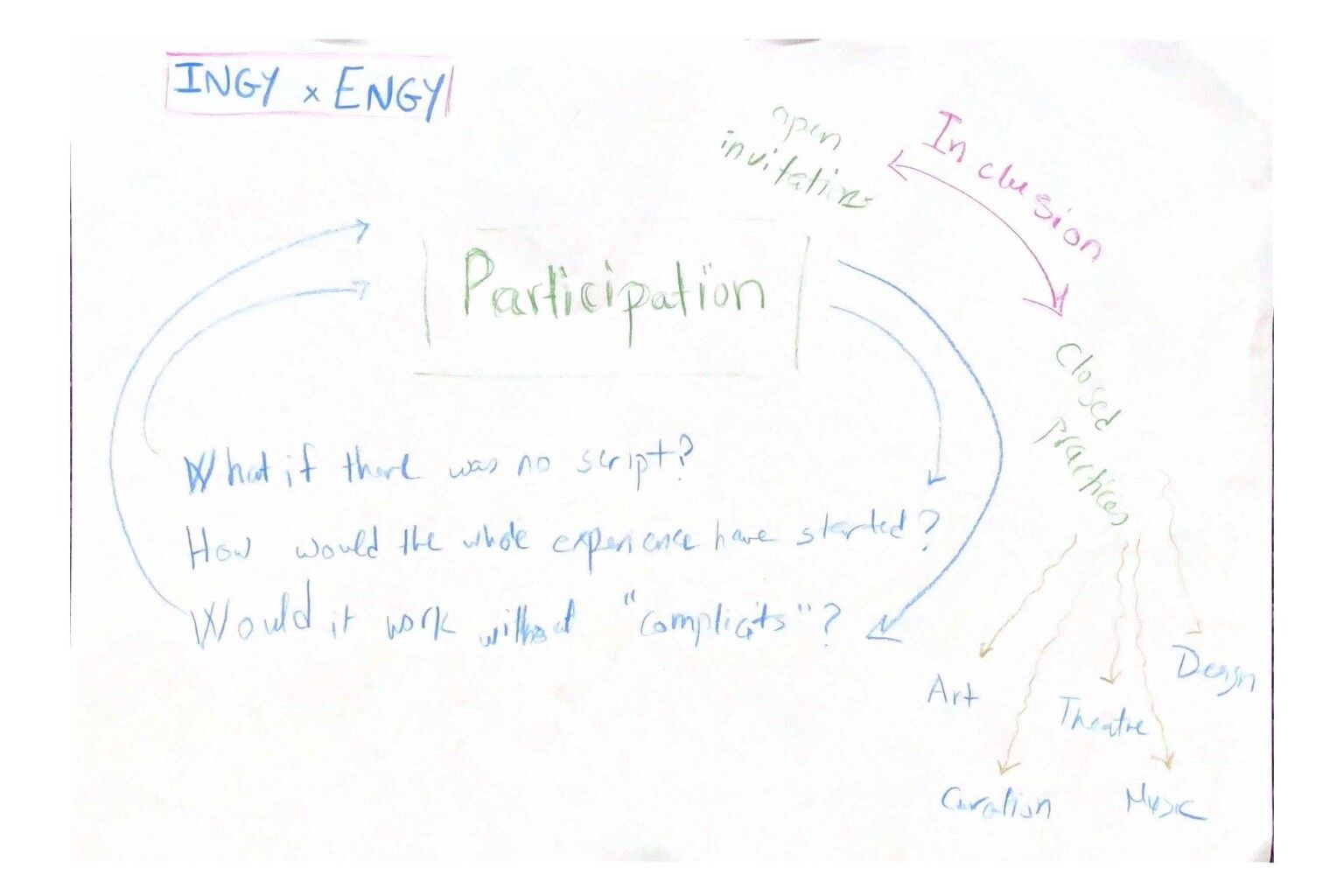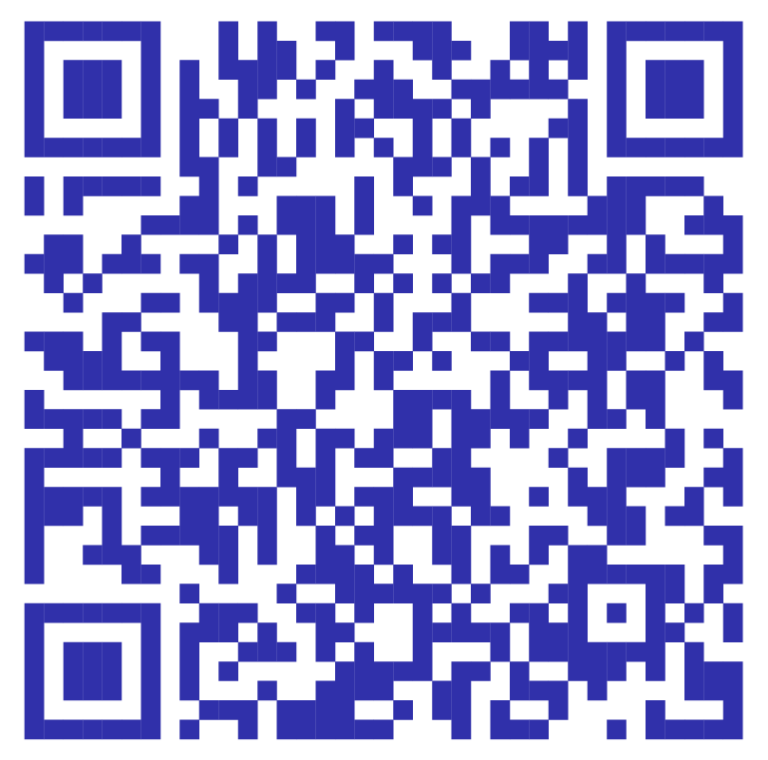Participating the Participatory
Our departure point for exploring participatory methods started, and later evolved, at the intersection of excitement, rage, inspiration and discomfort.
Excitement came from the discovery of a methodology that promised an inclusive, approachable, and ultimately democratic way of making decisions and taking action. Rage on the other hand, quickly followed after the realisation that this promising method wasn’t necessarily inclusive and sometimes led to more of an illusion of an all-encompassing democratic process than what is actually the case.

The first physical event of Participating Participatory on August 14, 2021 at Material, Zurich
As four people working within different fields: design, urbanism, theater, fashion to name a few, we were inspired to bring together approaches and tactics from different disciplines and to create a tool that would enable us to tackle these issues and, ultimately, pave the way for a more representative inclusion within participatory practices. Frustration emerged along the cracks of realization that we have more questions and issues coming to the surface than answers. While more and more questions tickled our minds, we realized that there should be a way to communicate this process of collective contemplation to those interested in exploring the subject of participation outside of our group. Conversational writing became a script in this way, which had its first lived experience in a small independent bookshop and gallery space Material in Zürich.
While we didn’t find the ultimate tool we were looking for that could help to solve the issues around the participatory processes, we have instead come up with a format of script reading that erases boundaries between host and participant, that lets the conversation flow in various directions and brings more perspectives, questions and sometimes solutions to surface. But before the script came to be, there were our thoughts, practices and experience, that interacted with the thinking of other practitioners, writers and artists, which makes revisiting our initial interaction with participatory methods particularly relevant.
Mujgan: “As a communication designer interested in community building, the notion of one designing “participation” for a given space has been an interesting subject for me for the past 2 years. Within these 2 years I have been part of various education classrooms, platforms, and groups where on some occasions I lacked the sense of belonging and questioned the value of my participation - am I included here just for the sake of ticking a box of an international student/designer, or does my voice really matter?
“My first experience with participatory methods in design took place as a part of a school assignment for one of the short-term courses I was taking, where we were tasked with collaboratively developing a brand identity for a student-led screen printing workshop space located near our university campus. In the initial phases of the project, I truly enjoyed how, for the first time, I was interacting with the local design students whom I did not know before due to our buildings being separated on campus. Through these new interactions I experienced how things can evolve as a result of collaboration as opposed to the product of isolation, as is the case with usual conventional design processes. Soon this excitement turned into disappointment when it came to naming the space - me and my friend, only 2 internationals in the room who did not speak fluent German were subtly excluded from the process as we were told that the space should serve locals and our suggestions were not local enough since we lacked the necessary vocabulary. Despite this conflict, it was still a valuable learning experience for me and since then I have been interested in the topic of designing through collaboration and participation - and most importantly questioning how one can ensure inclusiveness for a given space during the collaboration process to prevent what I experienced as an international student.”
“My interest in the participatory aspect of theatre stemmed from attending my first drama class during secondary school. I would say I have never been a lone wolf, which can be viewed as successful in the traditional sense in Asia, especially in a quite conservative boys school and because I am not so good at examinations, sports and music. The rehearsal room became the haven where I could put down the fixation on my personal achievement for a moment. The first lesson I learnt was about sitting in a circle: We are all equal in this circle. We can all see each other. And everyone can be seen. Everything is possible within this circle, and everything stays in this circle.
Witnessing the decline of humanity through because over-individualism, I always wondered if the way we work in the theatre, the circle, could be a better blueprint for our future. With this faith, I enrolled myself into theatre school after my first degree in Sociology, and, unfortunately, the reality proved me wrong. Besides being an art form, theatre is also (at least in Hong Kong) an entertainment business, and once again, there are always the genius artists who dictate the success of a performance, whose name is the Director.
As a directing student, I doubted the traditional sense of directing, and explored a more “democratic” way of theatre making, sharing the glory and the responsibility with the whole creative team. Some partners enjoyed working with me, but many complained about the invisibility of my vision as a director.
Can Theatre be democratized? What is the (power) dynamic between each fellow participant in Theatre?”
Car-driven and gentrifying cities hardly seemed a product of inclusive and community oriented city planning. Though, in the 2010s participatory planning started picking up pace and becoming an ever-present practice within mostly local scale projects, these projects could hardly deal with the large-scale, systematic problems of capitalist city production. This being said, they did offer a way of imagining otherwise.
I never really had a say or participated in the formation of the built environment around me, but always dreamed of how things could be more human-scale, convivial, truly public, and open access. Encountering and practicing tactical urbanism/placemaking projects whilst deploying participatory methods seemed like a promising way for enabling spaces where residents’ right to the city could be claimed. However in practice, this was not always the case. The more projects I started analysing or implementing myself, the more I realised it was really important who actually gets to sit around the table. As it stands, “the table” is mostly made up of those who are privileged enough to invest time from their weekends. Or those who speak out because they have been heard for most of their lives instead of being marginalised. Which leads to the questions, what kind of setups does the participatory process take place in? What does this setup mean in terms of inclusion? What could we do to make these setups more inclusive and meaningful?
What do I need to be able to act?
While performing as a contemporary dancer I always questioned how this is working out; learning the choreography, then putting your interpretation inside of it, in turn, creating new choreography and telling a narrative out of one idea, which actually includes a whole team behind it with a lot of different personalities. We were free in the sense of being free in the first framework of the choreography from our trainer. As in like, the first structure where we can move around for our own interpretations and interactions within the dancers by ourselves. So were we actually free in our participation or interaction after receiving this framework?
Though a different approach to this interaction, a similar question I came to while being in my fashion studies, was regarding the communication of my process to the world outside, especially given the “inside” of the fashion world was meant to be so exclusive, and excluding for “non-fashion-insiders”. How could I invite and encourage others to interact with me, how do I get them to have hands-on or at least communicate with them about the procedure? I realized it is an enormous question especially after our experiences the past months.
What has drawn me to join in with this research was not only the fascination with finding out what this title “Participating the Participatory” could mean and what to participate means for me personally, after experiencing different ways of interacting and researching, but rather, investigating how we could access this research to be open for everyone? At this point, it could have been everything and nothing at the same time. As I expected, this answer is linked to many more difficult questions about how society works and how we work within it. Although I always knew that the process of whatever I am doing is the most important part for me, and where we can connect the most, I honestly have to confess that I now stop chasing for results.
As we formed a study group of four frustrated, but hopeful researchers from different fields, we found more questions than answers everytime we met and discussed “Participation” through our little Zoom boxes. As we continued to discuss these questions we came close to the thought of whether the value of participation lies on the means rather than the goal. As event organizers, we can curate a playground for people to participate, but will participation run smoothly? No one knows. But we need to be brave enough to jump into the pool and accept what happens next. To jump into the sea alone is scary, but it will feel a little bit better, if we all jump together. Bravery in trusting others is something that we can cultivate everytime we participate. ‘’I think we get so lost in trying to define everything. And if your participation is your subjective experience, sometimes we want people to participate in something so we can look at what that means - instead of focusing on making them want to participate. So we shift the focus from the content itself to the question of how do ‘’We’’ define things? Actually, I think it gets quite dangerous when we always try to define everything instead of just living it, feeling it.’’
One of our participants brought this issue to our attention. How we automatically turn the expectation into a general question of definition. It is right, and we think it helps for achieving the right method, thinking or getting results. But instead of following this process, we get confused about who and how someone could give rules to something so broad and ungraspable.
The question of what is “Participation” obviously pushed our participants to their limits while trying to visualize the ideas around it. The same struggle was felt while questioning what we need to be able to act, no matter if you are the organizer, the participant without any clue, or an outside eye. The difficulties are there while already defining within these boxes of action. No wonder, we feel frustrated about not being able to act because of the definition of one's own space of moving and thinking.
As we do it in every part of our lives. Why not stop it? Get rid of it?
Does participation not happen all the time around us? Do we have to grab it? Do we have to make it seen? Isn’t it better to just be in its space, its process and appreciate the courage that it takes from everyone?


The visualizations show how colourful the layers of interaction are. Dependent on everything and everyone, it guarantees no guarantee. This is the point where we, as the research group, got more fascinated by how the whole thing had shifted to something so intangible, alive and honest. It is around us, all the time.
In the end, we found out it is about the balance of space for reaction, listening and silence.
When we started this research, School of Commons itself seemed an ultimate participatory entity shifting the focus from product to process, listening and taking into account opinions of fellows, addressing many issues that traditional art education failed to do. But SoC also has been super conscious about free labor, precarity and exploitation that participatory processes can result in. So the task of researching how SoC functions as a participatory entity somehow fell out of our focus, although initially that was the intention.
The peak of our interaction as a group, the moment of mutual understanding and trust in each other’s thoughts happened when we were able to physically meet in Zürich- where we made a rap about participation (sadly no one recorded this), we ate and drank together, thought and came up even with more questions, finalized our script that would hopefully never be truly finalized.
Our script presents an array of questions and thoughts from ourselves and other thinkers alike, as a conversation opener on participation and as a participatory act within itself. If you decide to take the script and make it a vehicle for your conversation around participation, it would be great for you to try and see what kind of notions, questions and conversations it brings to the surface.
Are you excited to try? Scan the respective QR codes for the audio file and the full Script text and follow our mini instructions below before you jump into it:
“Shall we be careful with participation as it might put extra labor on us? Do we take away the work of politicians in making informed decisions? And can this have dangerous results?” Extra labor of what?”
Script

Audio file

“Every performance is different and unique, so is life. The sound clip you will hear is a recording of the first live event we organized in Zurich, but please don’t treat it only as a replay of the archive, but allow us to suggest to you a new listening experience. Imagine you are one of the participants in the event, and your presence does matter. Here are some practices you may find useful for you to tune into the space.
To access the instructions, we used at the event: shorturl.at/btE08
Firstly, focus on your breathing, just give attention to it, rather than trying to control it. We believe there is no such thing as the perfect breathing method. Trust your body, it will find the best way to breathe at this moment. Just acknowledge what’s happening inside your body. Pay attention to when you breathe in, which part of your body will enlarge first and when you breathe out, which part of your body collapses first. What is the pattern of your breath? Long or short? Deep or shallow? Once again, all breathing is good, just observe it.
Then, pay some attention to the body parts that are supporting your weight. Are you standing on your feet, or sitting on a chair? Or in other words, where is the ground? The ground that supports you as always. Now take a moment to close your eyes, and sense the ever shifting relationship between your weight and the ground.
Before you press the play button, I would like you to close your eyes once again. Where are you right now? Where is every object surrounding you?
And here you go, listen, pause, think, write, reflect and if you ever want to talk, reach out to us.
We hope your interaction with the script was insightful and relatable. To this date, we have held one physical and three online sessions where we have invited the attendants of the event to read through and reflect on the script together with us. At the physical session we also deliberately didn’t state who is the host and who are the participants, so only one of us started reading the script, we deliberately left pauses for others to pick up the space, talk about relevant experience or read another part from script that seemed interesting to them. This way the boundaries between host and participants were blurred, which enabled everyone to add a layer of their own experience to the train of our thoughts.
Nazakat Azimli
Nazaket (she/her) is an urbanist, researcher and project manager with a background intertwining between development cooperation, curation, placemaking and participatory planning.
Muj Abdulzade
Muj is a designer and researcher with interests in collage, writing and community building.
Chiara Alissa Estivariz Lopez
Chiara holds a Master’s degree in Visual Cultures, Curating, and Contemporary Art from Aalto University and a Bachelor’s in Fashion from Pforzheim University.
Siu Hei
Siu Hei is a theatre director from Hong Kong, and currently studying his masters in dramaturgy in Zurich University of the Arts.